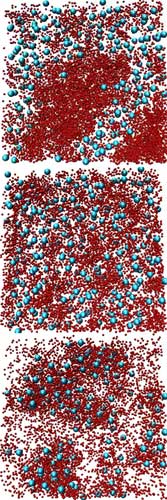Goldilocks Proteins
 Milky-white cataracts, the world's leading cause of blindness, can occur when proteins in the lens of the eye aggregate into clumps. Researchers recently reported that although one pure lens protein forms clumps, a mixture of that same protein with another lens protein is less clumpy. By comparing experiments with extensive computer simulations, they conclude that the effect arises because the two proteins attract each other, but not too strongly. The new information on lens protein interactions could have benefits beyond cataract research because controlling similar attractions could help keep particles dispersed in material and food processing.
Milky-white cataracts, the world's leading cause of blindness, can occur when proteins in the lens of the eye aggregate into clumps. Researchers recently reported that although one pure lens protein forms clumps, a mixture of that same protein with another lens protein is less clumpy. By comparing experiments with extensive computer simulations, they conclude that the effect arises because the two proteins attract each other, but not too strongly. The new information on lens protein interactions could have benefits beyond cataract research because controlling similar attractions could help keep particles dispersed in material and food processing.Read more about this research at Physical Review Focus
Text courtesy of Physical Review Focus.
Two different-sized eye-lens proteins, modeled as spheres in this simulation, segregate if their mutual attraction is too small (top) and clump if it is too large (bottom), but they stay mixed if the attraction is just right (center).











